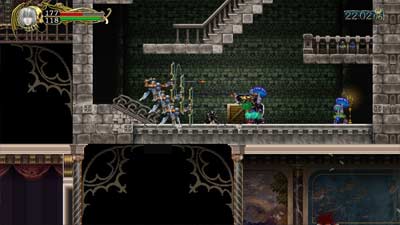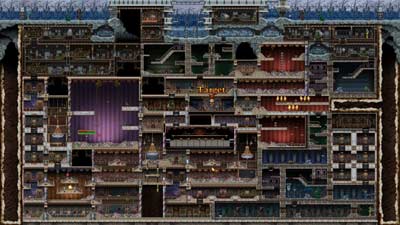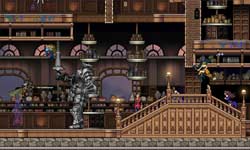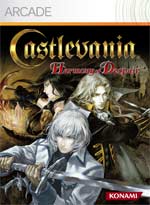Castlevania with Friends!
Castlevania is one franchise that has stood the test of time. Whether you are playing on the SNES or the Nintendo DS, if you tell someone you are playing Castlevania, images of running and jumping through massive castles and an ultimate battle with Dracula immediately spring to mind. Like all its predecessors, Castlevania: Harmony of Despair keeps this same basic format. However, this time, you can play with friends online!

When you start the game, you are given the choice to either play solo or multiplayer. If you love the single-player experience, it is possible to play through all of the game’s maps by yourself. In fact, I would recommend at least one or two playthroughs on your own before jumping into the game’s multiplayer modes, as the maps are quite complex, and you don’t want to slow your team down when playing online.
Before you start your first level, you are able to pick one of several different Castlevania characters to play as. Although the original Belmonts are strangely absent, you can play as Alucard, Soma Cruz, Jonathan Morris, Charlotte Aulin, or Shanoa. Each character retains their special powers from previous games, which makes it easy for players to find a fit for their individual playing style. For instance, while Alucard thrives off close combat, Shanoa uses ranged attacks almost exclusively. Of course, all characters can be outfitted with new weaponry and plenty of secondary/tertiary attacks, so even if you pick a character that doesn’t necessarily fit your game style, you can customize them accordingly.
The character customization system in Castlevania: Harmony of Despair is also surprisingly deep. Different items can be used for both offense and defense, and you can use equipment you find in treasure boxes to enhance your character’s stats, RPG-style. When I started the first level, I felt underpowered, and it wasn’t until my third or fourth try (after equipping my character to the nines with new weapons and armor) that I was able to make some headway in the initial level.

However, like most Castlevania players, I am not one to shy away from a challenge, and Harmony of Despair provides ample difficulty for even the most seasoned players. Of course, this difficulty level is mitigated by the fact that most of the levels in Castlevania: Harmony of Despair are designed to be played with others. Although each level can technically be played solo, shortcuts and bonus rooms exist that require two or more players to operate switches and clear pathways for other players. Bosses are also much easier with more than one player, and the “Revive” system for fallen allies is essential for success with long fights.
The levels are initially presented in a zoomed-out view where you can see all of the rooms, dungeons, and traps contained within the level. Of course, while the level is zoomed out, your character looks like a flea, so you can’t really play. However, this zoomed-out view can help those who want to plan a specific route to maximize treasure or minimize contact with enemies, for example. Once you have gotten the lay of the land, you can then tap on the left thumbstick to zoom into your character’s general area. This view is still a little wide, but helps you get a closer look at surrounding rooms. However, the standard Castlevania view can be achieved with a third click of the left thumbstick, and only lets you see your character and immediate surroundings.

The view system is especially useful in Castlevania: Harmony of Despair because it allows you to quickly assess both your position and the position of others who are playing with you. Although you’ll have to switch between views quickly to achieve the maximum effect of this feature, it proves to be useful and enhances the gameplay. The game also uses a “windowed” view to allow you to see where other characters are in relation to you. This makes searching for other players in the zoomed-out view much quicker and more efficient.
Though the different views sound like a small feature, it is these small touches that give Castlevania: Harmony of Despair its great gameplay. For example, the gameplay is improved by the presence of “safe” rooms where characters can equip and use items. These rooms are smartly done, as you don’t want members of your team suddenly stopping mid-level to equip every item they find or check their character’s stats. Although there are only a handful of safe rooms in each level, they are frequent enough that you should be able to navigate to one easily if you (or your team) decide to use some newfound items.

In addition to the straight-up co-op mode, there is also a competitive mode that pits you against up to five players. The competitive mode adds a nice bonus to the gameplay, but the real replay value will come from the cooperative modes. Not only do you get the shared experience of playing through Castlevania, but you can build your characters quickly through cooperative play and discover more items. If you are like me, you hate leaving any item unclaimed in RPG-style games, so if you are trying to unlock everything, you’ll need to play through the game several times.
The visuals in Castlevania: Harmony of Despair recall older titles. The entire visual scheme is pixel-based, but like the BlazBlue and King of Fighters series, the pixels are small and make up a gorgeous and unique picture. The only qualm I had with the visuals was the way the look of the game changed when you switched from the full to the zoomed-in view. Although animations were smooth throughout, when the game is zoomed-in, some areas appear blocky. Still, these occasional hiccups never impacted the gameplay, and I was impressed with the level of detail throughout as well as the quality of the animations in the full view (you’ll have to squint, but you can see every character and enemy in the level moving)!
Castlevania: Harmony of Despair is a great title for both fans of Castlevania and for those just getting into the series. The new co-op element will certainly add a layer of depth to the title unseen in previous releases, and the RPG aspects ensure that there is plenty of replay value here. Although the game does seem a bit hollow if you are playing by yourself, playing with friends is a blast. Be warned, the game is one of the pricier XBLA titles (weighing in at 1200 points) and it only features six levels. If you like playing with friends or have a passion for Castlevania, you’ll find some enjoyment with this title, but if you prefer a single-player focused experience (or have never played a Castlevania game), then you may not be as impressed with Harmony of Despair.
RATING OUT OF 5 RATING DESCRIPTION 4.1 Graphics
Castlevania Harmony of Despair’s 2-D visuals impress overall, though the “zoomed in” view you are likely to use with the single-player mode does suffer from some blocky elements. 4.3 Control
The controls are the same as you remember, and actions can be assigned to different buttons depending on your own preferences. 3.8 Music / Sound FX / Voice Acting
The music is retro-inspired but nicely varied throughout the game’s six levels. 4.2 Play Value
The co-op and competitive modes make this game ripe for several playthroughs, and finding all of the game’s items creates an additional challenge. 4.1 Overall Rating – Great
Not an average. See Rating legend above for a final score breakdown.
Game Features:
